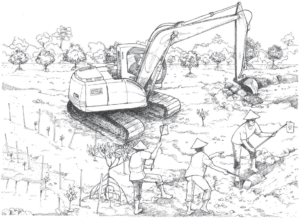Picture credits: Cinnamon Nature Trails
“All’s not well with the Sri Lankan elephant with more than 350 dying each year (on average) due to the Human Elephant Conflict (HEC). Many scientists who study Sri Lankan wild elephants are of the view that maybe the tipping point has already been reached, where viable, stable populations are not prevalent in Sri Lanka anymore. It is imperative therefore that all stakeholders urgently get-together and implement a holistic, overarching conservation plan (details of which have been talked about for so long) to save this wonderful animal that has brought so much fame and glory to Sri Lanka”. Srilal Miththapala
On August 12, we commemorated World Elephant Day to raise awareness of the possible threats to Elephants and to focus on acknowledging the significance of the Elephant in the ecosystem.
The two baby elephants are under the protection of the herd. Image courtesy of Chitral Jayatilake
The Sri Lankan subspecies Elephas maximus Maximus is said to be the biggest and darkest of the Asian elephants. These elephants were once spread out throughout our island, but construction operations have cleared forests and disrupted their long-distance migration patterns, forcing them into smaller more restricted locations.
In Sri Lanka, a herd can have up to 20 individuals. The matriarch, or eldest female, is in charge. According to reports, herds in Sri Lanka include nursing units, which are made up of lactating females and their young, and juvenile care units, which are made up of females and young elephants. Since the start of the 19th century, the number of elephants in Sri Lanka has decreased by over 65%. Currently, killing an elephant is punishable by death under Sri Lankan law, which protects the species.
Image by Rajiv Welikala.
Elephants in Sri Lanka are endangered species. They may weigh up to 5400 kg and stand an average height of roughly 11 feet. An adult elephant would often consume 300–400 pounds of food every day and drink 25–50 gallons of water. In general, a Sri Lankan elephant lives 55 to 70 years, which is comparable to the lifespan of an African elephant.
The main issue facing Asian Elephant conservation, particularly in Sri Lanka, is the Human Elephant Conflict. Asia will inevitably release more and more space for human settlements and novel development projects due to its extraordinarily high population density and quick rate of population expansion. As a result, elephants are losing land and habitats that can feed them and support their way of life. Because of this, more than two-thirds of Sri Lanka’s elephants reside outside of protected areas. This opens the door for significant conflict between the two species. Several strategies, including elephant translocation, elephant drives, and electric fences, have been used to reduce it. Education and learning to live in harmony with nature are the only and best ways to address issues associated with Human Elephant Conflict. Future research should focus on Modern and Co-Existence Solutions for the conflict.

















